A Transparency Report is a PDF that will tell you if a business has real or fake reviews.
It contains a:
- Cover Page
- Analysis Page
- Review Pod Analysis Page (if present)
- Google Review - Transparency Data Table
- Transparency Fraud Metrics Breakdown
Why should you read it
A transparency report provides deep insights into the legitimacy of user-generated reviews on Google Maps. With this data you can:
- Make a choice if you want to work with this company
- Understand the type of review fraud that may be occurring
- Provide evidence of fake reviews for review disputes/takedowns
- Submit evidence of review fraud to professional licensing boards
- Protect your brand from franchise owners using deceptive marketing tactics.
- Submit complaints to the Department of Consumer Affairs and the Federal Trade Commission
How to read a Transparency Report
Start with the Cover Page, the cover page will
- Identify if you have the right business
- Show a verified or failed badge, to help you understand our overall analysis.
- Provide a statement about the badge, to help you understand our overall analysis.
- Provide an ID number in case you want to contact us (very important)
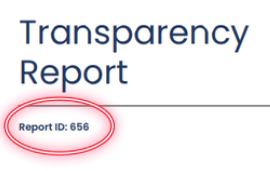
The Analysis Page will:
Provide a breakdown and visualization of all of our publicly shared metrics. This is where you can understand what makes real reviews, real.
Review Breakdown
We break down the reviews based on legitimacy. Here we visualize how many real reviews (both positive and negative) we see, as well as how many fake reviews (both positive and negative). You can learn more about the reviews are legitimate or suspicious by scrolling down below in the reviews table.
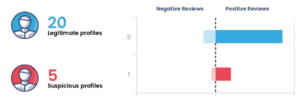
AI/NLP
We use machine learning to identify unique authorship styles. This is helpful when looking for reviews written by the same author. If you have a business with 100 reviews, there should be 100 unique authors. Human beings all write differently, have different vocabularies, and the different ways they use grammar and syntax. We use NLP to predict the number of unique authorship styles.
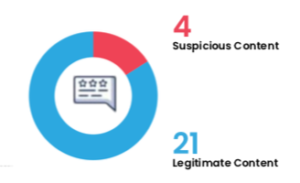
Review Pod Analysis
The review pod analysis measures if there are large groups of reviewers who have reviewed the same businesses. While this does happen organically, we typically only see it with larger businesses with 500+ reviews. For smaller businesses with less than 500 reviews, this is often a sign of someone being paid to publish reviews as all of the customers will be within the pod. We have fun metrics to grade pods so we can predict if it's organic or purchased.
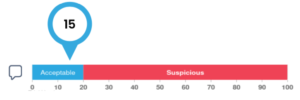
Low Engagement Profiles / Anonymous Reviewers
Anonymous reviews is the #2 actionable metric we detect. Too many anonymous reviewers normally mean fraud, so be sure to include those in your dispute reports. Below you'll find the names of the reviews with the ANON tags to the right. When a business has too many reviews from low engagement profiles, it’s often a sign of a business paying for reviews. Typically, when you see businesses with 75% or more of 1 profile 1 review, we get highly suspicious. This does occur naturally, especially with all of the advanced software designed to solicit feedback.
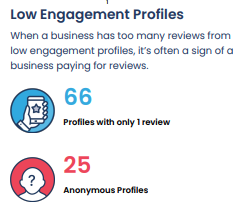
Distance Matrix Analysis
The distance matrix analysis collects the average distance between the businesses reviewed by the contributor. While people travel, the average person stays within a 107-mile radius of their hometown. When we see contributors with reviews all over the world, our suspicion goes up. It does help create a unique perspective.
Be sure to look at the map with an open mind. Some businesses serve customers nationwide, like marketing agencies, media companies, hotels, etc. Some businesses, however, are much more local and have customers they mainly stay close to home.

How to read the Review Pod Tables:
Review pods are when you have a group of 2 or more reviewers, writing companies for the same 2 or more businesses.
This happens all the time, naturally. Especially with word-of-mouth businesses, and business networks. For example, real estate agents typically work with the same home inspectors, roofers, and landscapers repeatedly. So when you see a few people write reviews for a real estate agent and the same local home inspection company, don't be alarmed.
Things to be wary of with Review Pods:
- Pods with 4+ reviewers
- Pods with different states
- Pods with weird category diversity
- Pods with the same business but different location
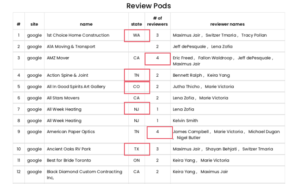
Things that look normal
- Larger businesses
- In-network businesses
- other local businesses
Google Review - Transparency Data Table
There are 8 fields that we use to display all of the reviews and their corresponding metrics.
# | author | rating | text | dma | kra | tis | kma
# - we use the same order that Google uses when displaying reviews, from first to last
author - this is the name of the reviewer/contributor to help you identify a specific review
text - this is the first 74 characters of the review to help you identify a specific review
dma - this is the average distance between all the businesses reviewed but this contributor
kra - this is the keyword stuffing analysis that measures frequency of relevant keywords for this business
tis - this is a category diversity metric that measures the category diversity, higher numbers are less diverse.
kma - this is a very basic metric that identifies the number of grammar errors, humans make mistakes. bots don't.
Transparency Fraud Metrics Breakdown
This is a table to get the definitions of each metric, for each report.
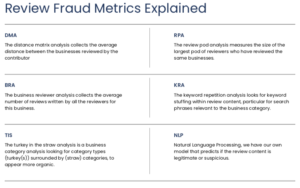
Questions to ask yourself after reading the report
Is there anything on the report that looks fishy? Suspicious?
Have you checked other sites for consistency?
If it's a professional, have you checked for any disciplinary action?
Is the business urging you to rush into purchasing, or creating a huge sense of urgency?
What does your gut instinct tell you?